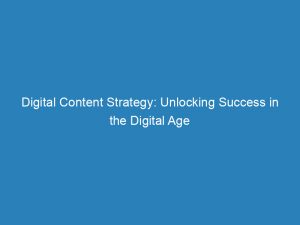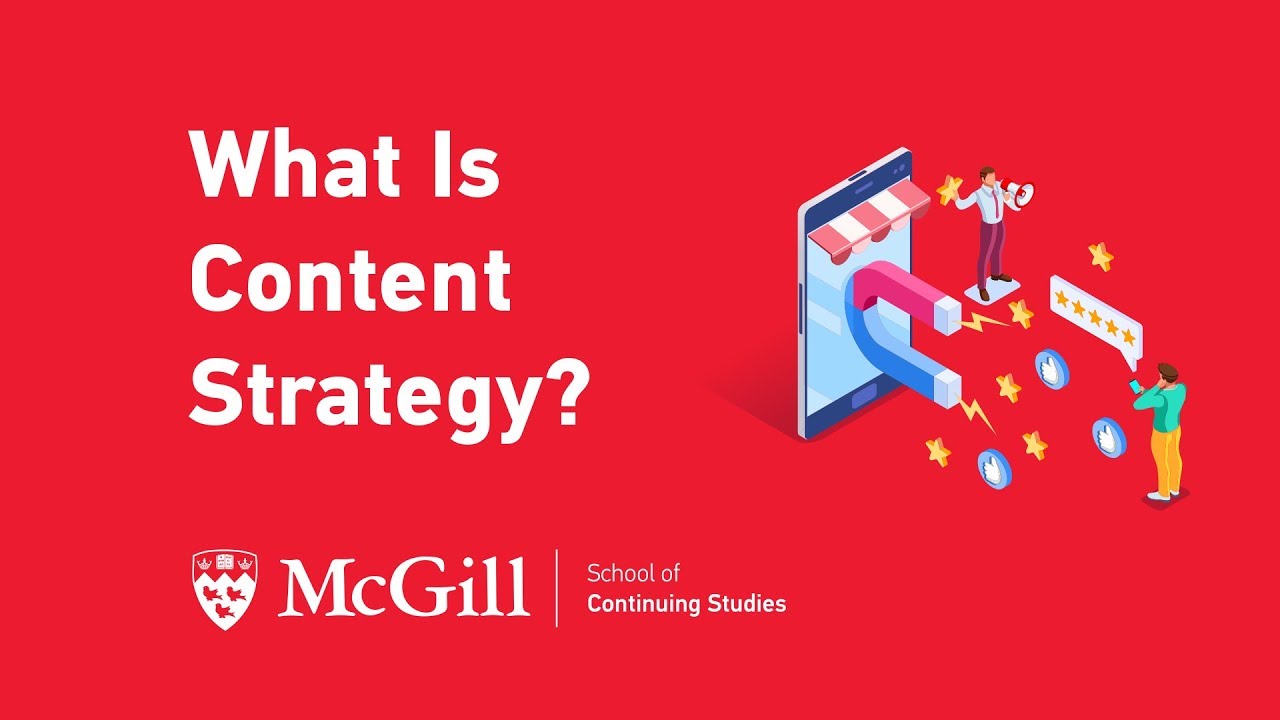In today’s fast-paced digital world, having a solid contentstrategy is key to standing out and capturing the attention of your target audience. A well-thought-out digitalcontentstrategy can help you attract and engage your audience, build brand awareness, and ultimately drive results.
But where do you start? From developing a unique contentstrategy based on your individual strengths to optimizing your content for maximum reach, there are countless factors to consider.
In this guide, we will take you on a journey through the various steps involved in creating and executing a successful digital content strategy. So buckle up and get ready to revolutionize your online presence.
Table of Contents
- digital content strategy
- Personalizing Your Content Strategy
- Defining Your Mission Statement
- Understanding Your Target Audience
- Evaluating And Enhancing Existing Content
- Choosing The Right Content Management System
- Selecting The Type Of Content To Create
- Generating Engaging Content Ideas
- Managing And Analyzing Your Published Content
digital content strategy
A digital content strategy is a systematic approach to creating and managing content online. It involves various steps, such as defining a personal mission statement, conducting persona research, and running a content audit.
The goal is to align content with business goals and target audience interests and needs. By choosing a content management system (CMS) and determining the type of content to create, such as blog posts or videos, you can effectively publish and manage your content.
Using tools, like Feedly and market research, can help generate trendy content ideas. It’s crucial to optimize content for reach by refining ideas, conducting keyword research, and utilizing tools like HubSpot’s Blog Ideas Generator.
Additionally, organizing and scheduling content publication with editorial and social media calendars is essential. Consider different types of content marketing and tailor them to specific platforms based on the target audience’s preferences.
Through market research, you can identify which platforms your target audience is on. Ultimately, a successful digital content strategy requires time, organization, and creativity.Key Points:
- Digital content strategy involves creating and managing online content systematically.
- Steps include:
- Defining a mission statement
- Conducting persona research
- Running a content audit
- The goal is to align content with business goals and target audience interests and needs.
- Choosing a CMS and determining content type allows for effective publishing and management.
- Tools like Feedly and market research help generate trendy content ideas.
- Optimizing content for reach through:
- Refining ideas
- Keyword research
- Using tools like HubSpot’s Blog Ideas Generator
- Organizing and scheduling content publication with:
- Editorial calendar
- Social media calendar
- Different types of content marketing tailored to platforms based on the target audience’s preferences
- Market research helps identify the platforms your target audience is on
- Successful digital content strategy requires time, organization, and creativity.
Sources
https://creators.google/en-us/content-creation-guides/content-strategy-guides/how-to-create-a-content-strategy/
https://blog.hubspot.com/marketing/content-marketing-plan
https://blog.hubspot.com/marketing/content-marketing
https://expresswriters.com/digital-content-strategy-guide/
Check this out:
💡 Pro Tips:
1. Incorporate interactive elements into your digital content strategy, such as quizzes, polls, and interactive infographics, to engage and delight your audience.
2. Utilize user-generated content by encouraging your audience to share their experiences and opinions related to your brand or industry.
3. Develop a content promotion plan to ensure your digital content reaches the right people, through strategies like social media advertising, influencer partnerships, and email marketing.
4. Regularly update and repurpose your existing content to keep it relevant and maximize its reach, such as turning a blog post into a video or creating an infographic from a white paper.
5. Implement SEO practices in your digital content strategy to improve its visibility on search engines, by conducting keyword research, optimizing meta tags and headlines, and building high-quality backlinks.
Personalizing Your Content Strategy
In the world of digital content, one size does not fit all. Each content strategy should be unique to the individual and their strengths and weaknesses.
Personalizing your content strategy allows you to leverage your unique qualities and deliver content that resonates with your target audience. This approach sets you apart from the competition and enables you to establish a strong online presence.
To begin personalizing your content strategy, it is important to define a personal mission statement that reflects the purpose of creating content. This statement serves as a guiding light, directing your content creation efforts and ensuring consistency across all platforms.
It allows you to stay true to your values and mission, which in turn helps build trust with your audience.
Defining Your Mission Statement
Your mission statement should clearly articulate the reason behind your content creation efforts. It shapes your content strategy, helping you identify your target audience, their needs, and the goals you want to achieve through your content.
Enhanced readability and refreshed statistics.
A well-defined mission statement provides a roadmap for creating content that aligns with your objectives.
To create a mission statement, ask yourself questions like “What do I want to achieve with my content?”, “Who is my audience?”, and “What unique value can I offer?”. The answers to these questions will help you craft a concise and meaningful mission statement that serves as a foundation for your content strategy.
Understanding Your Target Audience
In order to create content that resonates with your audience, it is essential to conduct thorough persona research. Persona research involves analyzing your target audience’s demographics, interests, behaviors, and pain points.
This deep understanding of your audience allows you to create content that addresses their specific needs and provides valuable solutions.
By understanding your target audience, you can tailor your content to their preferences and interests. This personalized approach ensures that your content is relevant and valuable to them, increasing engagement and driving conversions.
Persona research also helps you identify the most effective channels and platforms to reach your audience, enhancing the overall impact of your content strategy.
Evaluating And Enhancing Existing Content
Before diving into creating new content, it is important to evaluate your existing content and determine areas for improvement. This involves conducting a content audit, which entails analyzing your current content’s performance, relevance, and quality.
By identifying strengths and weaknesses in your existing content, you can make informed decisions on how to enhance and optimize your future content.
During a content audit, consider factors such as engagement metrics, traffic sources, and conversion rates. This data provides insights into which pieces of content are performing well and resonating with your audience.
Additionally, it helps you identify gaps in your content strategy, identifying areas where new content could be created to address unmet needs or boost engagement levels.
Choosing The Right Content Management System
A content management system (CMS) plays a crucial role in managing and organizing your digital content. It is important to choose a CMS that suits your needs and aligns with your content strategy.
A robust CMS should provide a user-friendly interface, customizable templates, and integrated analytics tools.
When selecting a CMS, consider factors such as scalability, ease of use, and flexibility. Ensure that the CMS you choose allows you to efficiently manage your content and streamline your publishing process.
By using a CMS that meets your specific requirements, you can save time and effort in content management, allowing you to focus on creating engaging content.
Selecting The Type Of Content To Create
Content comes in various forms, including blog posts, videos, social media posts, ebooks, case studies, infographics, podcasts, and more. The type of content you choose to create depends on your goals, target audience preferences, and the resources available to you.
Consider your strengths and skills when deciding on the type of content to create. For example, if you are a skilled writer, blog posts may be a natural fit.
If you have a charismatic personality and are comfortable in front of the camera, videos or podcasts might be the way to go. By leveraging your strengths and producing content that aligns with your abilities, you can create impactful and engaging content.
Generating Engaging Content Ideas
Once you have defined your mission statement and selected the type of content you want to create, the next step is to generate engaging content ideas. Brainstorming content ideas ensures that your content is fresh, relevant, and resonates with your target audience.
To generate content ideas, consider your mission statement, target audience needs, and current industry trends. Brainstorming sessions can be done individually or as a team, encouraging creativity and collaboration.
Use tools like the Feedly RSS feed and market research to track trendy topics and identify content gaps in your niche. These resources help you stay up-to-date with the latest industry developments and generate fresh ideas for your content.
Managing And Analyzing Your Published Content
Once your content is published, it is important to have a system in place to manage and analyze its performance. This involves using a content calendar and analytics tools to track engagement metrics, monitor audience feedback, and evaluate the success of your content strategy.
A content calendar helps you stay organized by scheduling and managing your content publication. It ensures a consistent flow of content and allows you to plan ahead, maximizing the impact of your content.
Analytics tools provide insights into how your content is performing, which allows you to make data-driven decisions and refine your strategy based on what resonates with your audience.
In conclusion, a successful digital content strategy requires personalization, strategic planning, and continuous analysis. By personalizing your content strategy to align with your strengths and weaknesses, defining a mission statement that reflects your purpose, understanding your target audience, and evaluating and enhancing existing content, you set yourself up for success.
Choosing the right content management system, selecting the type of content to create, generating engaging content ideas, and managing and analyzing your published content are all key elements that contribute to the effectiveness of your digital content strategy.
Self-Serve DSP Platform • Performance Marketing Tips • Programmatic Advertising • Buy Traffic












